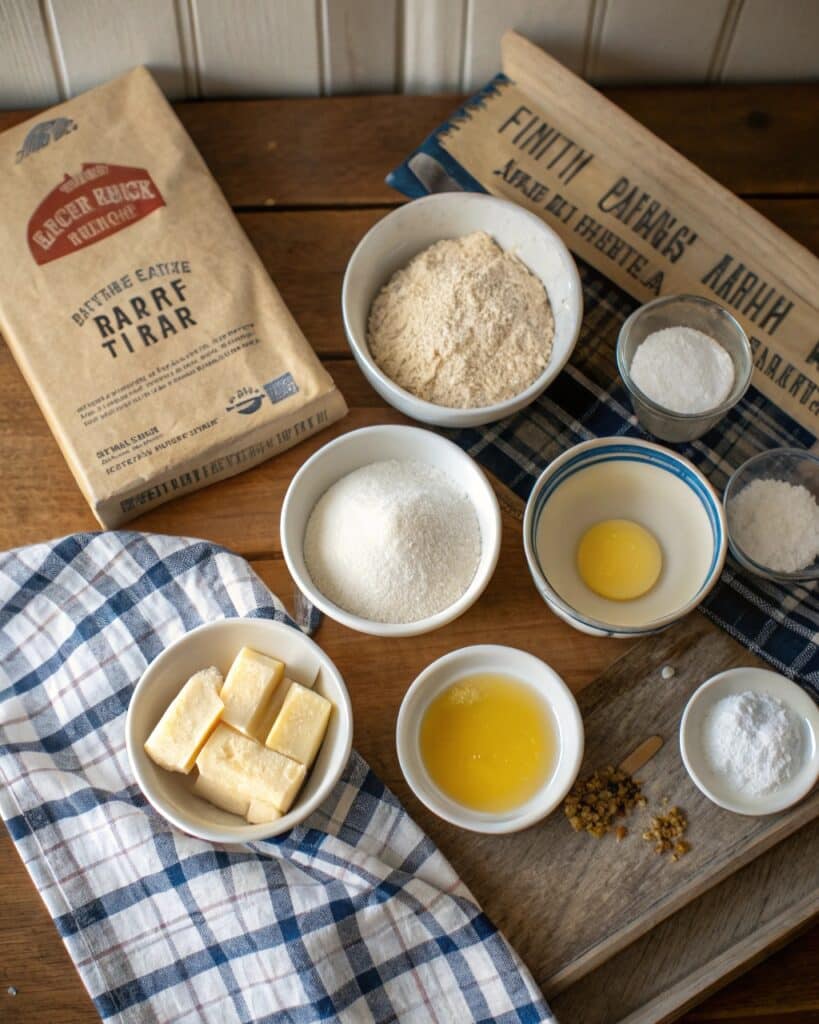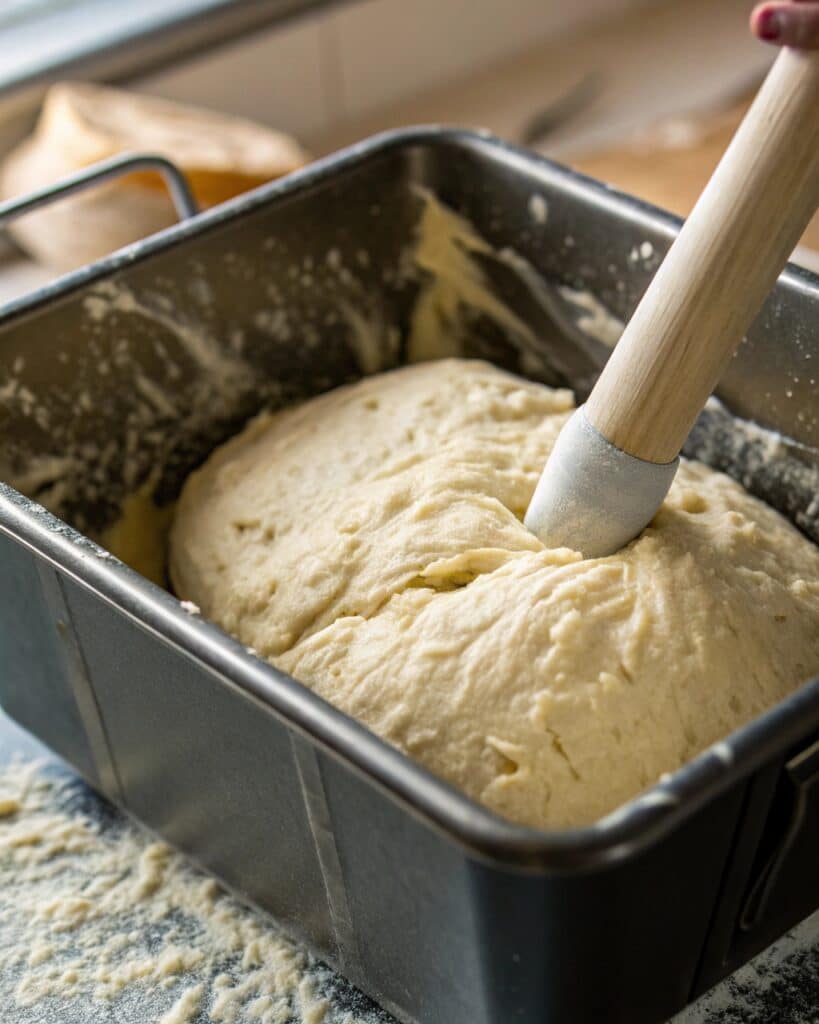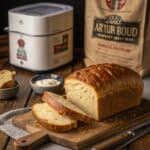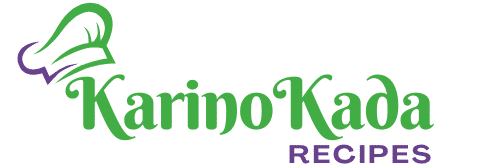There’s something incredibly comforting about coming home to the warm scent of freshly baked bread—and when it’s a King Arthur bread machine recipe, you know it’s going to turn out just right. Whether you’re an old-school bread machine enthusiast or just dusted yours off for the first time in years, you’re about to rediscover why this kitchen workhorse deserves a comeback.
The Story & Ingredients
From Asheville to the Bread Machine: Why I Swear by King Arthur Flour
Hi there, I’m Grace Holloway, and I’ll be honest—my bread machine sat untouched in a cabinet for years. I bought it during a snowstorm panic in 2012, used it twice, and then let it gather dust behind an unopened fondue set. But then last spring, while knee-deep in my backyard’s overly ambitious herb patch, I stumbled upon my grandmother’s handwritten recipe cards and decided to give homemade bread another go.
That day, I pulled out my old machine, adjusted her vintage knobs, and tried a King Arthur bread machine recipe I’d found online. The results? A soft, golden loaf with a chewy interior and a crust that is very satisfying. The kind of bread that makes even a simple tuna sandwich feel like a deli masterpiece.
If you’ve ever struggled with sunken centers or cardboard crusts, King Arthur flour might be the missing piece. Its consistency and high-quality protein content makes it ideal for bread machine baking. Now, I bake a loaf every Sunday—sometimes basic, sometimes loaded with herbs or studded with seeds.
And I’m not alone. As bread machine baking resurges in popularity, recipes like this one make it easy to see why. (Just like my favorite Ezekiel Bread or that rustic Date Nut Bread I keep coming back to.)
Let’s dive into the ingredients that make this recipe the perfect starting point.
Ingredients for a Classic King Arthur Bread Machine Recipe

Whether you’re a beginner or a seasoned baker, this straightforward ingredient list gets the job done every time. These proportions are perfect for a 1.5–2 lb loaf.
| Ingredient | Quantity |
|---|---|
| King Arthur Bread Flour | 3 cups |
| Warm water (110°F) | 1 1/4 cups |
| Olive oil or unsalted butter | 2 tablespoons |
| Sugar or honey | 2 tablespoons |
| Salt | 1 1/2 teaspoons |
| Active dry yeast | 2 teaspoons |
| Optional: dry herbs or seeds | 1–2 tablespoons |
Pro Tip: Always add liquids first and yeast last (make a small well in the flour for it) to prevent premature activation.
If you’re looking for a gluten-free version, try browsing something like Flourless Cottage Cheese Bread—a unique twist that pairs beautifully with savory spreads.
Mini Recipe Story (60 words for print/card)
One snowy afternoon, I dusted off my old bread machine and gave King Arthur flour a go—and that golden loaf changed everything. Perfect crumb, reliable rise, and unmatched flavor. Now it’s part of our Sunday routine, just like grandma’s handwritten cards. Trust me, this King Arthur bread machine recipe might just become your new favorite ritual.
Step-by-Step Bread Machine Instructions
How to Make King Arthur Bread in a Bread Machine (the Easy Way)
Using a King Arthur bread machine recipe takes the guesswork out of homemade bread. The ingredients are reliable, and when paired with the precision of a bread machine, success is nearly guaranteed. Whether you’re baking a weeknight loaf or preparing something special like this Cranberry Walnut Bread, this method is just as satisfying.
Let’s walk through the steps, with a few key tips to help your loaf bake beautifully every single time.

Step-by-Step Instructions:
- Layer the Ingredients
Open your bread machine pan and begin by pouring in the warm water (not hot—110°F is ideal). Add the olive oil or melted butter first, then mix in the sugar or honey and salt. - Add the Flour
Carefully spoon the King Arthur bread flour into the pan so it sits on top of the wet ingredients. Do not compress the flour; leave it loose to keep the hydration level correct. - Add the Yeast (and Optional Mix-ins)
Make a small well in the center of the flour and pour in the active dry yeast. If you’re adding dried herbs, flax seeds, or other mix-ins, sprinkle them along the outer edges of the flour—not directly in the yeast well. - Choose Your Setting
Close the lid and select the basic white or sandwich bread setting. For most bread machines, this cycle lasts around 3–4 hours. Choose the light crust option unless you prefer extra crunch. - Check the Dough Early
After about 5 to 7 minutes of kneading, open the lid and check how the dough looks. It should form a soft ball—not too wet, not too dry. Add a teaspoon of flour or water if necessary. - Let It Work
Once the dough looks good, close the lid and let your machine handle the rest—kneading, rising, and baking. - Cool It Right
When the cycle ends, remove the pan and transfer the bread to a wire rack immediately. Let the bread sit for at least 30 minutes before cutting it to avoid a sticky center.
Troubleshooting & Tips for Success
- Flat Top? That usually means too much water or over-proofing. Measure water carefully.
- Dense Texture? Use bread flour, not all-purpose. has King Arthur bread flour the right protein level for baking bread.
- Crumbly slices? Reduce the sugar slightly and ensure full cooling before slicing.
Curious why King Arthur flour works so well? Their high-protein formula gives bread structure and a consistent rise—just like in my Marble Rye Bread Recipe, where structure makes all the difference.
Looking to experiment? Try swapping honey for maple syrup or folding in nuts for a hearty twist—just like those soft slices from Blueberry Fluffy Cottage Cheese Cloud Bread, but with a golden crust your machine nails every time.
Why Bread Machines (and King Arthur Flour) Are Making a Comeback
Are Bread Machines Outdated—or the Future of Homemade Bread?
Not long ago, bread machines were mostly unused, reminders of the 1990s. But now, they’re rising in popularity again, just like a well-proofed loaf. So, why are we falling back in love with bread machines? It starts with convenience—but the real magic happens when you pair that ease with quality ingredients like King Arthur flour.
Many believe bread machines disappeared because of their clunky size or because home bakers leaned into sourdough. Others say grocery store convenience pushed them out. But let’s be honest: nothing compares to the smell of fresh bread made right in your kitchen—especially when all it takes is five minutes of prep and the push of a button.
This is where the King Arthur bread machine recipe shines. It removes the intimidation factor from baking. You don’t need to knead by hand or worry about fermentation science. Your machine handles everything from start to finish. Add in King Arthur’s dependable flour—which offers high protein and consistent texture—and you’re rewarded with perfect slices every time.
Why King Arthur Flour Stands Out for Bread Machine Recipes
If you’ve ever baked with subpar flour, you know the results can vary wildly. Too soft. Too chewy. Sometimes dense. That’s why I use King Arthur—it’s the oldest flour brand in America for good reason. The protein levels are listed clearly, it’s unbleached, and every bag is milled to the same standard. For a bread machine, that means consistency in rise, crumb, and crust.
It’s the reason this same recipe gave me bakery-level results—even better than the Banana Bread Recipe from Hawaii I used to rely on for brunch.
If you’re still doubting your dusty machine, I get it. But give this recipe a try with King Arthur flour, and you’ll understand why this combo is earning a fresh spot on kitchen counters across the country.

FAQs About Bread Machines & King Arthur Flour—Answered
Is King Arthur Flour Suitable for Bread Machines?
Absolutely, and in fact, you should. King Arthur offers a line of flours—especially their bread flour and all-purpose flour—that’s perfect for machine baking. Their bread flour contains a higher protein content (12.7%) than many competitors, giving your dough structure and stretch. Whether you’re making basic white or a hearty loaf like this Cinnamon Donut Bread, King Arthur flour holds up beautifully during the kneading and baking cycles.
Is King Arthur Flour Good for Bread Making?
Yes—King Arthur is widely trusted by both professionals and home bakers. It’s unbleached, never bromated, and milled for consistency. That means every bag performs the same, so your recipes turn out right every time. That’s especially important in bread machines, where ingredient ratios are exact. Using high-quality flour like King Arthur reduces the chance of collapsing loaves or gummy centers.
Why Are Breadmakers No Longer Popular?
While bread machines dipped in popularity during the 2010s, they’ve made a strong comeback—especially during recent years when many rediscovered baking at home. The truth is, many people didn’t understand how to use them effectively. Pairing a solid recipe like this King Arthur bread machine recipe with reliable flour solves that problem. Machines today are also quieter, smaller, and more versatile than their clunky predecessors.
What Ingredients Are Needed for a Bread Machine?
A basic loaf usually includes:
- Flour (like King Arthur’s Bread or AP)
- Water
- Yeast
- Salt
- A fat (oil or butter)
- A sweetener (sugar, honey)
Optional add-ins like herbs, nuts, or seeds can improve the bread. Looking for fun variations? Try adding ingredients similar to this Cloud Bread made with cottage cheese for protein-packed softness.
Conclusion
The King Arthur bread machine recipe isn’t just easy—it’s reliable, satisfying, and absolutely worth your Sunday routine. Whether you’re new to bread machines or rekindling an old love, the combination of a quality machine and top-tier flour like King Arthur is the recipe for success.
Bread machines aren’t a thing of the past. They’re a quiet hero for busy kitchens. When paired with dependable ingredients, they deliver golden, crusty loaves that taste like they came from a bakery—even if your hands never touched the dough.
So go ahead—dust off your machine, stock up on King Arthur flour, and give this recipe a whirl. Like I did, you might just find yourself baking every week… and loving every slice.
Print
King Arthur Bread Machine Recipe That Always Works
- Total Time: 3 hours 5 minutes
- Yield: 1 loaf 1x
- Diet: Vegetarian
Description
This King Arthur bread machine recipe yields a soft, golden loaf with a chewy crumb. It’s beginner-friendly, requires only pantry staples, and turns out beautifully every time.
Ingredients
3 cups King Arthur Bread Flour
1 1/4 cups warm water (110°F)
2 tablespoons olive oil or unsalted butter
2 tablespoons sugar or honey
1 1/2 teaspoons salt
2 teaspoons active dry yeast
Optional: 1–2 tablespoons herbs or seeds
Instructions
1. Add warm water, oil, sugar, and salt to the bread machine pan.
2. Add King Arthur flour on top, spreading evenly.
3. Make a small well in the center and add yeast.
4. Select the Basic or Sandwich Bread setting (3–4 hours).
5. Check the dough after 5 minutes; adjust moisture if needed.
6. Let the machine finish the cycle fully.
7. Remove loaf and cool on a wire rack for 30 minutes before slicing.
Notes
Use bread flour, not all-purpose, for best structure.
King Arthur’s protein consistency helps maintain rise and texture.
Add-ins like herbs or seeds should be placed away from the yeast.
- Prep Time: 5 minutes
- Cook Time: 3 hours
- Category: Bread
- Method: Bread Machine
- Cuisine: American
Nutrition
- Serving Size: 1 slice (1/12 loaf)
- Calories: 140
- Sugar: 2g
- Sodium: 190mg
- Fat: 3g
- Saturated Fat: 1g
- Unsaturated Fat: 2g
- Trans Fat: 0g
- Carbohydrates: 24g
- Fiber: 1g
- Protein: 4g
- Cholesterol: 0mg

